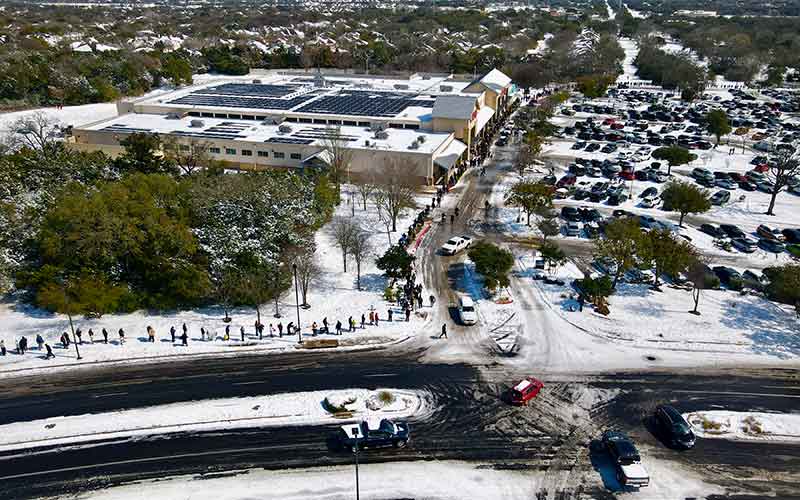
After the power grid failure in Texas, people lined up for hours to find non-perishable food. Photo Credit: Shutterstock.
A previous version of this blog was published on March 11, 2021.
Two years ago this month, the Texas power grid failed in the middle of a severe winter cold snap. Local cell towers were knocked offline, nearby hospitals had to relocate patients, temperatures inside homes and businesses dropped to the 40s without heat, and the water soon shut off.
Stranded for days without power or water and with dwindling food supplies, millions of people suffered during this untenable situation – one that cost at least 246 lives. Sadly, it could have been avoided had state power generators heeded the lessons from past winter disasters and taken needed precautions.
New England is no stranger to ice storms, of course, and the Texas power grid is very different from ours. But we can still learn from the Texas crisis – especially given the cold snap that gripped the East Coast on Christmas Eve of 2022. This snap caused grid failures in which fossil fuel facilities in New England went offline, forcing us to rely on burning more expensive and climate-damaging oil to generate electricity.
While New England is much better prepared for plummeting temperatures than Texas, we still have a long way to go. Our region continues to rely heavily on fossil fuels to produce electricity – fossil fuels and their infrastructure that are clearly not reliable given their vulnerability to cold weather. In fact, the power plant outages that nearly caused blackouts in New England on Christmas Eve all occurred at fossil fuel facilities. So, here’s what we can learn from the Texas power grid failure.
Why Did the Texas Power Grid Fail in 2021?
The Texas grid failed for two primary reasons: It did not build its power sources to withstand cold weather, and its isolated grid can draw only limited power from outside the state. Either of these factors alone would have been problematic. Together, they spelled disaster.
Let’s start with the weatherization issue. Despite more than a decade of warning, Texas’ power generators never made their infrastructure resilient to extreme weather. The result? Sixty percent of their natural gas, coal, and nuclear power froze up and went offline.
But Texas power generators chose not to prepare. So, power generators ignored the lessons from 2011 and left vulnerable a power grid that millions of people rely on.
Texas’ “Go-It-Alone” Grid Left It Isolated
Even with those failures, the blackouts might not have been so widespread if Texas could draw emergency power from neighboring grid systems. But Texas has deliberately isolated itself, refusing to meaningfully connect its grid to any other outside the state. It did so mainly to avoid federal regulation – the same kind of regulation that could have forced its power generators to make all those upgrades recommended back in 2011.
This isolation also meant that when the state’s primary power producers were forced offline by the record cold temperatures, the grid operator had no backups to draw on to keep the power flowing.
Could This Happen in New England?
Comparing the Texas and New England power grids is apples and oranges for a lot of reasons. However, the issues in Texas do have lessons for us here.
Weather everywhere is already more extreme and erratic – and it’s going to get worse. We must prepare for it. Lives are at stake, and we can’t afford to make mistakes. Regional grid operators – including here in New England – should all be planning ahead to ensure their power systems are resilient and versatile, especially in times of crisis.
And let’s get this out of the way: Frozen wind turbines were not the problem in Texas and won’t be an issue here. While anti-renewable pundits were quick to blame them, wind and solar have no problem operating in far colder temperatures. There are functional wind turbines as far north as the Arctic Circle, after all. It’s just a matter of being prepared.
New England’s Grid Isn’t Isolated, But That’s Not Good Enough
A critical limitation that all regions must address is inter-regional planning and interconnection. There are nine regional power grid networks across the United States. The New England states form one of these – managed through a regional grid operator called ISO-New England.
Unlike Texas, New England’s grid already connects to those of our neighboring region and nearby Canadian provinces. However, ISO-New England can do much more to plan transmission and access to power on an inter-regional basis. Such a plan would make power available from adjacent regions in case part of the grid failed. This connection can ensure that, with help from our neighbors, the lights and heat stay on during weather catastrophes. Resource sharing like this would also help New England avoid the cost of over-building our regional power system to guard against outages.
Carrying out this resource-sharing plan also means upgrading our transmission infrastructure – the lines that carry power from one region to another. The goal: to make our infrastructure more resilient to climate change’s uncertain impacts and boost the overall power system’s versatility in times of system stress. That upgrade requires regional cooperation and big-picture planning, because, as we’ve seen in Texas, the costs of inaction are far higher than the upfront costs of investing in clean energy and upgrading the grid.
Clean Energy Is Critical to a Cleaner, More Resilient Future
While upgrading these interconnections is important, local power solutions are equally critical to ensuring our grid’s versatility and resilience. Specifically, we’re talking about solar panels and battery storage.
Local, renewable power adds another element of diversity and resilience to the resources available to keep the lights on. These resources give our homes and businesses independent sources of energy and provide ISO-New England, the grid operator, more sources of electricity any time of the year. They also provide an option to avoid widespread blackouts during an emergency.
Also, right now, ISO-New England over-relies on dirty fuels like gas. To truly prepare us for the future, our grid operator needs to embrace local and large-scale renewable energy. Wind and solar can – and must – lead the way in our clean energy transformation. In fact, it’s the only way to slow even worse climate-induced disasters to come.
We know clean energy can successfully power our electricity grid, lowering pollution and consumer cost in the process. So, having both measures – a strong inter-regional connection to neighboring grids and small and large clean energy sources distributed throughout the region – ensures our system is versatile, flexible, and clean.
What Happens Now?
What happened in Texas was a humanitarian crisis. And despite everything Texas went through, they just doubled down on fossil fuels with a plan that incentivizes more gas fired power plants in the state. We must ensure we avoid such a situation here.
Preparing New England’s grid for the future means upgrading our transmission infrastructure. It also means that ISO-New England and our utility companies must look holistically at the power system, factor state policies and laws around clean energy into their planning, create electricity markets where clean energy resources can compete fairly, and acknowledge that energy is a necessary service. They can’t count on business-as-usual when climate change impacts are already here. The upfront investments needed are well worth the lives and money saved later.
We are pushing ISO-New England to follow the states’ vision for a clean, affordable, and reliable 21st-century electric grid. Because we have a duty to keep our communities safe from the worsening fallout of our climate crisis.




